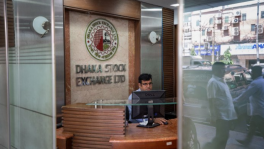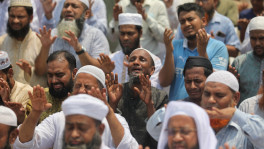They are third graders and yet cannot read Bangla
Study finds 79% children lack the skills not just in reading and understanding Bangla, but their writing skills are also substandard

Despite Bangla being the mother tongue and the primary means of communication in Bangladesh, a staggering 73 percent of third-graders cannot properly read and understand the language from their textbooks.
As many as six percent students cannot read Bangla words from textbooks at all while only 21 percent are proficient in reading the language. Beyond textbooks, 9.4 percent of them can read Bangla with correct pronunciation.
The revelation was reflected in a study published by the National Academy for Primary Education (NAPE) titled "Weakness of Grade Three Students in Bangla: Causes and Remedies" in 2019.
A NAPE team conducted the survey on 592 students from 16 schools across eight upazilas of eight districts from January to May this year. They also interviewed 16 teachers from those schools.
The surveyed districts are Mymensingh, Gopalganj, Khagrachhari, Bogura, Khulna, Sylhet, Dinajpur and Bhola.
The students performed poorly not just in reading and understanding Bangla, but their writing skills are also substandard. As many as 65 percent of students cannot properly write Bangla sentences, 14 percent cannot even write words and only 21 percent is proficient in writing.
In Mymensingh district, the aptitude of third graders was much better 23 years ago, compared to the current situation. A NAPE report published in 1996 revealed 63 percent of third-graders in the district had shown proficiency in Bangla.
The students' aptitude in the language was unsatisfactory two years ago.
A NAPE study in 2017 found that 51.7 percent of students who passed third grade could not read Bangla sentences from their textbooks and 53 percent failed to read text outside their textbooks.
As many as 73 percent of students could only read single words.
Last year, fifth-grade students also demonstrated poor skills in Bangla. The National Student Assessment Report 2018, published by the Directorate of Primary Education, showed only 12 percent of fifth-graders had the proficiency to properly pass their Bangla examination.
The 3rd Primary Education Development Program, a baseline survey conducted by the Directorate of Primary Education in 2015, showed that less than 25 percent of third-graders could read Bangla fluently.
Commenting on the matter, Assistant Specialist of NAPE Muhammad Salahuddin said, "We tried our best to bring out the real scenario of third graders' proficiency in the Bangla language."
The latest NAPE study showed that the third graders performed in listening and speaking skills relatively well compared to reading and writing skills.
Thirty-eight percent of students showed proficiency in listening and understanding Bangla from textbooks while 10 percent had difficulties.
Meanwhile, 28.6 percent of students showed competency in understanding texts beyond their textbooks while 5 percent could not understand what was being read to them. Sixty four percent of them were proficient in communicating in Bangla.
Causes behind the inaptitude?
The NAPE study found that the major causes behind the inaptitude of students are their lack of concept regarding the four language skills, poor teaching techniques of the teachers and insufficient practice of Bangla in classrooms.
Inadequate planning and preparation by the teachers affect the practice of Bangla language in the classroom. In addition, the assessment process of Bangla language is not being conducted using proper techniques.
The study also found that the students do not have enough opportunity to use supplementary Bangla reading material.
Rasheda K Chowdhury, executive director of Campaign for Popular Education, said, "The quality of primary education is very poor. It is a concerning scenario that only 21 percent of third-graders can read and understand Bangla properly.
"The situation has been persisting for many years. The government is yet to ensure the quality of primary education. The scenario might be worse than the NAPE findings. It is very important that the students get proper education."
She continued, "Teachers, guardians and other stakeholders can ensure proper education. But everyone is busy chasing GPA-5s. Learning has become less important in schools and homes.
"We have been asking the government to stop exam-centric education and eliminate the Primary Education Completion examination. But they are yet to pay heed to our demands."
Addressing the issue, Akram-Al-Hossain, secretary to the primary and mass education ministry, said, "The government is working to ensure quality education by handing out new books, stipends and providing the schools with meals and biscuits.
"We have increased the enrollment rate and decreased the dropout rate of students from 50 percent in 2006 to 18 percent in 2019. We have introduced the 'One Day One Word' programme for all students and put extra emphasis on mathematics."
There are 133,901 government and non-government primary schools in the country and 66, 983 among them are government-run institutions. There are 623,964 teachers and 17,251,350 students in Bangladesh.
Among them, 386,296 are female teachers and 237,668 are males. The number of female students is 8,743,312 and male students is 8,508,038. The teacher-student ratio in government primary schools is 37:1 and in non-government primary schools it is 16:1.
On paper, Bangladesh has developed the primary education sector. The government is spending over a thousand crore taka every year on stipends for primary school students and last year alone Tk 1,550 crore was set aside for this purpose.
Each student from 67,000 government primary schools gets Tk100 a month and some selected schools get free meals from the World Food Programme. That has helped attain an enviable 98 percent primary education enrolment rate.
The Primary Education Development Programme has apparently failed to ensure quality primary education in the country although it helped increase the enrollment rate of students.
The enrollment rate increased from 87 percent in 2005 to 98 percent in 2018, according to the Bangladesh Bureau of Educational Information and Statistics Report 2019.
The primary education sector has already completed three stages of the programme. The fourth stage has been running since the fiscal year 2017-18.


 Keep updated, follow The Business Standard's Google news channel
Keep updated, follow The Business Standard's Google news channel














